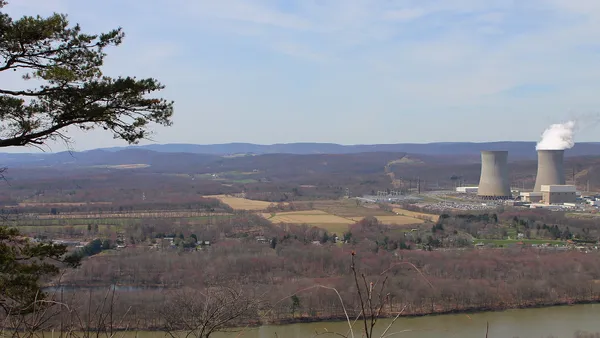This post has been updated to reflect comments from Pacific Gas & Electric.
Dive Brief:
- Local mayors and nuclear energy supporters are among the parties challenging Pacific Gas & Electric's plan to close the 2,240 MW Diablo Canyon nuclear plant and replace it with a combination of renewables and efficiency.
- Six mayors of cities in San Luis Obispo County, where the plant is located, filed with regulators last week, asking them to deny the plan due to inadequate planning for its impacts on surrounding communities. They also asked for a third party to review long-term affects of the closure and for PG&E to disclose nuclear waste plans for the site.
- Nuclear backers, including the nonprofit Environmental Progress, also filed for rejection of the plan, arguing PG&E used "false" cost data to substantiate its case and that closing the plant will raise carbon emissions. PG&E officials say there is "no basis" for those claims.
Dive Insight:
When PG&E announced this summer it would close the Diablo Canyon nuclear plant after 2025, the cost of the plant was a main driver.
Due to more renewable energy and greater efficiency, PG&E calculated it would not need to run the Diablo Canyon plant 24/7 after 2025. Adding in the cost of expected upgrades and maintenance, the utility estimated it would cost $0.10/kWh to operate the plant if its license were extended in that year — more than double what it had expected.
But in a Sept. 15 filing, Environmental Progress argues the utility overestimated the costs to comply with California's once-through cooling (OTC) regulations for power plants, and that the plant would still be cheaper than many alternative sources with the upgrade.
"PG&E's entire CPUC Application to raise rates rests on this cost information. As such, the CPUC — bound by law to protect ratepayers over special interests — cannot allow PG&E to raise rates," Environmental Progress President Michael Shellenberger wrote in a statement.
Ralph Cavanagh, lead negotiator for the Natural Resources Defense Council in the Diablo Canyon closure deal, emphasized that the cost estimates came from the plant operator itself and that PG&E had no reason to inflate them.
"The reason PG&E did this is they took a hard look at the long-term economics of operating the plant beyond its current license," he told Utility Dive. "The contention that somehow there is no chance that PG&E would have to install cooling towers, for example, PG&E itself disagrees with that."
While cooling costs beyond 2025 are not set in stone, Cavanagh said it is "entirely likely that the plant's cooling costs will increase substantially."
"But if you look at the PG&E cost estimates, it isn't even clear that cooling was dispositive," he said. "PG&E concluded it was more than $0.10/kWh and even if you took the cooling costs out you'd still be at $0.08/kWh."
Environmental Progress has been one of the most vocal opponents of the closure proposal since PG&E announced the plan in June, calling parties to the deal "corrupt" and implying they may have been "acting illegally."
Cavanagh said those critiques misunderstand the rationale behind PG&E's move.
"It's not news that groups that like nuclear power and groups that don't have very different assumptions about costs and operating characteristics, but the argument here is with the plant owner, not with NRDC," Cavanagh said. "The fact that the owner is the source of the numbers makes that a more difficult case to make."
PG&E, which will file reply comments by Sept. 26, said that while Environmental Progress may disagree with their cost estimates,
"There is no merit to Environmental Progress’ claims regarding information that was used to support the Diablo Canyon cost estimates in the joint proposal application, specifically information regarding once-through cooling requirements," spokesperson Blair Jones wrote in an email. "PG&E clearly stated in its testimony that once-through cooling mitigation cost estimates were included in its forecast that detailed the cost of continuing to operate Diablo Canyon, and made available detailed information as to how these costs were calculated. PG&E was also quite clear that the once-through cooling mitigation costs were estimates, not actual costs."














